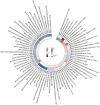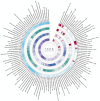Unveiling genetic links between gut microbiota and asthma: a Mendelian randomization
- PMID: 39372270
- PMCID: PMC11449699
- DOI: 10.3389/fmicb.2024.1448629
Unveiling genetic links between gut microbiota and asthma: a Mendelian randomization
Abstract
Background: Multiple studies suggest a potential connection between the gut microbiome and asthma. Our objective is to use advanced genetic and metagenomic techniques to elucidate the causal relationships and underlying mechanisms between gut microbiota and asthma.
Methods: The study utilized comprehensive Linkage Disequilibrium Score Regression (LDSC) and Mendelian randomization (MR) analyses to examine the relationship between 119 gut microbiota genera and asthma, using publicly accessible genome-wide association studies (GWAS). The meta-analysis synthesized summary effect estimates obtained from LDSC, forward MR, and reverse MR. The MiBioGen collaboration, involving 18,340 individuals, identified genetic variations associated with gut bacteria. Asthma data were collected from the UK Biobank, FinnGen, and GERA, encompassing a total of 82,060 cases and 641,049 controls.
Results: LDSC analysis revealed significant negative genetic correlations between asthma and RuminococcaceaeUCG004 (Rg = -0.55, p = 7.66 × 10-5) and Subdoligranulum (Rg = -0.35, p = 3.61 × 10-4). Forward MR analysis suggested associations between Butyricicoccus (OR = 0.92, p = 0.01), Turicibacter (OR = 0.95, p = 0.025), Butyrivibrio (OR = 0.98, p = 0.047), and reduced asthma risk. Conversely, Coprococcus2 (OR = 1.10, p = 0.035) and Roseburia (OR = 1.07, p = 0.039) were associated with increased risk. Reverse MR analysis indicated significant associations between genetically predicted asthma and Eubacteriumxylanophilumgroup (Beta = -0.08, p = 9.25 × 10-7), LachnospiraceaeNK4A136group (Beta = -0.05, p = 1.26 × 10-4), and Eisenbergiella (Beta = 0.06, p = 0.015, Rg_P = 0.043).
Conclusion: The findings underscore significant genetic correlations and causal relationships between specific gut microbiota and asthma. These insights highlight the potential of gut microbiota as both markers and modulators of asthma risk, offering new avenues for targeted therapeutic strategies.
Keywords: Linkage Disequilibrium Score Regression; Mendelian randomization; asthma; gut microbiota; meta-analysis.
Copyright © 2024 Zheng, Chen, Zhuang, Zhao, Qian and Shi.
Conflict of interest statement
The authors declare that the research was conducted in the absence of any commercial or financial relationships that could be construed as a potential conflict of interest.
Figures






Similar articles
-
Genetic associations between gut microbiota and allergic rhinitis: an LDSC and MR analysis.Front Microbiol. 2024 May 24;15:1395340. doi: 10.3389/fmicb.2024.1395340. eCollection 2024. Front Microbiol. 2024. PMID: 38855765 Free PMC article.
-
Genetic associations between gut microbiota and type 2 diabetes mediated by plasma metabolites: a Mendelian randomization study.Front Endocrinol (Lausanne). 2024 Aug 9;15:1430675. doi: 10.3389/fendo.2024.1430675. eCollection 2024. Front Endocrinol (Lausanne). 2024. PMID: 39184139 Free PMC article.
-
Assessing causal relationships between gut microbiota and asthma: evidence from two sample Mendelian randomization analysis.Front Immunol. 2023 Jul 19;14:1148684. doi: 10.3389/fimmu.2023.1148684. eCollection 2023. Front Immunol. 2023. PMID: 37539057 Free PMC article.
-
Causal associations between gut microbiota, metabolites and asthma: a two-sample Mendelian randomization study.BMC Pulm Med. 2024 Feb 7;24(1):72. doi: 10.1186/s12890-024-02898-x. BMC Pulm Med. 2024. PMID: 38326796 Free PMC article.
-
Genetic liability of gut microbiota for idiopathic pulmonary fibrosis and lung function: a two-sample Mendelian randomization study.Front Cell Infect Microbiol. 2024 May 22;14:1348685. doi: 10.3389/fcimb.2024.1348685. eCollection 2024. Front Cell Infect Microbiol. 2024. PMID: 38841114 Free PMC article.
Cited by
-
Multi-trait Analysis of GWAS Expands Eosinophilic Esophagitis Genetic Susceptibility and Polygenic Risk Scores.Res Sq [Preprint]. 2025 Jul 18:rs.3.rs-6630283. doi: 10.21203/rs.3.rs-6630283/v2. Res Sq. 2025. PMID: 40470207 Free PMC article. Preprint.
-
Mechanisms of Aletris spicata (Thunb.) Franch. Extract in Asthma Therapy: Oxidative Stress, Inflammation, and Gut Microbiota.Biology (Basel). 2025 Jun 19;14(6):731. doi: 10.3390/biology14060731. Biology (Basel). 2025. PMID: 40563981 Free PMC article.
References
LinkOut - more resources
Full Text Sources

